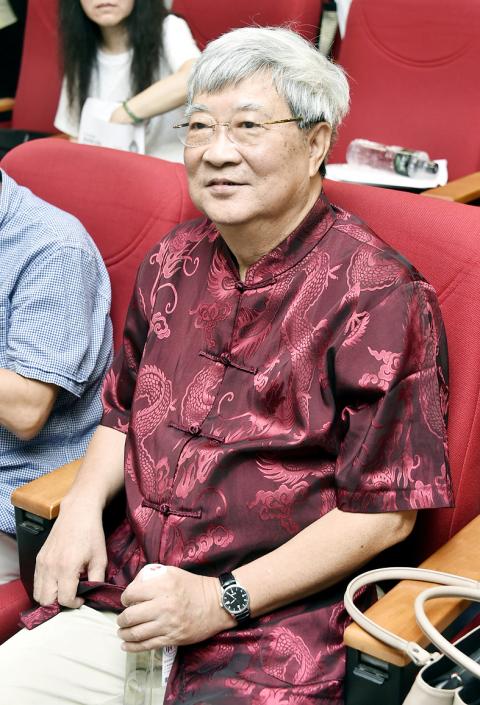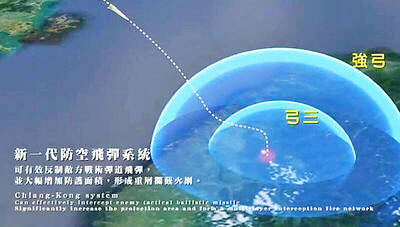Netizens yesterday accused the Chinese Nationalist Party (KMT) of using education as a propaganda tool for the promotion of its “one country, two areas” (一國兩區) formula, reacting to an article published by a news Web site in China featuring the convener of the Ministry of Education’s curricular adjustment committee, Wang Hsiao-po (王曉波).
Titled “Returning Taiwan’s History Textbooks to ‘One China’: Not Everyone is [former president] Lee Teng-hui (李登輝),” the article published by the Chinese media Web site Guancha.cn on April 29 has triggered heated discussion since it was reposted on the nation’s largest online academic bulletin board system, Professional Technology Temple (PTT), yesterday morning.
Shih Hsin University professor Wang was quoted in the article as saying that the reason adjustments were proposed to high-school curriculum guidelines three years after its implementation was because of misinformation in some history textbooks.

Photo: Chen Yi-chuan, Taipei Times
Some textbooks inaccurately described so-called “comfort women” as having volunteered to work in wartime brothels in Japan, he was quoted as saying.
“They also painted Taiwanese who were enlisted to serve in the Imperial Japanese Army during World War II as willingly joining the Japanese Army out of patriotism,” he said.
As former of the Chinese Unification Union vice chairman Wang has been a magnet for controversy.
His remarks often trigger an outpouring of fury from the online community, as did his recent accusation that Democratic Progressive Party chairperson Tsai Ing-wen (蔡英文) incited young students to stand up against curriculum changes.
The remark by Wang during a Taiwanese political talk show on Friday that “our country’s capital is Nanjing, but Taipei is the current capital of the Taiwan area” has also resulted in much criticism from netizens.
In the article published by Guancha.cn, Wang was quoted as saying that the biggest changes were made to the geography textbooks, which were drawn up based on the principle of “one country, two areas.”
The adjustments include a change from “China’s largest island is Hainan, while our country’s highest peak is Jade Mountain (玉山)” to “The largest island is Taiwan. Our nation’s highest peak is Mount Everest and its Taiwan area is surrounded by water,” Wang wrote.
Asked what kind of impact the curriculum adjustments had on the KMT’s campaign for next year’s presidential and legislative elections, Wang said they had created a strong cohesive force among pan-blue supporters.
“A lack of ‘national goals’ is a critical problem facing the KMT. The party requires more convincing rhetoric to persuade the public and that was exactly what we aimed to achieve through the curriculum changes,” Wang said in the article.
In an article published in the Chinese-language monthly magazine Straits Review (海峽評論) in September last year, titled “Textbooks on Japanese occupation and Taiwanese history” (日據與台灣史教科書), Wang wrote that the 2012 revisions of high-school curriculum guidelines were the result of compromises that were, in his opinion, “unsatisfactory, but acceptable.”
“After being incorporated with China-centric East Asian cultural history... the 2012 revisions allow Chinese history to take up more than two semesters of teaching hours,” Wang said.

LIMITS: While China increases military pressure on Taiwan and expands its use of cognitive warfare, it is unwilling to target tech supply chains, the report said US and Taiwan military officials have warned that the Chinese People’s Liberation Army (PLA) could implement a blockade within “a matter of hours” and need only “minimal conversion time” prior to an attack on Taiwan, a report released on Tuesday by the US Senate’s China Economic and Security Review Commission said. “While there is no indication that China is planning an imminent attack, the United States and its allies and partners can no longer assume that a Taiwan contingency is a distant possibility for which they would have ample time to prepare,” it said. The commission made the comments in its annual

DETERMINATION: Beijing’s actions toward Tokyo have drawn international attention, but would likely bolster regional coordination and defense networks, the report said Japanese Prime Minister Sanae Takaichi’s administration is likely to prioritize security reforms and deterrence in the face of recent “hybrid” threats from China, the National Security Bureau (NSB) said. The bureau made the assessment in a written report to the Legislative Yuan ahead of an oral report and questions-and-answers session at the legislature’s Foreign Affairs and National Defense Committee tomorrow. The key points of Japan’s security reforms would be to reinforce security cooperation with the US, including enhancing defense deployment in the first island chain, pushing forward the integrated command and operations of the Japan Self-Defense Forces and US Forces Japan, as

‘TROUBLEMAKER’: Most countries believe that it is China — rather than Taiwan — that is undermining regional peace and stability with its coercive tactics, the president said China should restrain itself and refrain from being a troublemaker that sabotages peace and stability in the Indo-Pacific region, President William Lai (賴清德) said yesterday. Lai made the remarks after China Coast Guard vessels sailed into disputed waters off the Senkaku Islands — known as the Diaoyutai Islands (釣魚台) in Taiwan — following a remark Japanese Prime Minister Sanae Takaichi made regarding Taiwan. Takaichi during a parliamentary session on Nov. 7 said that a “Taiwan contingency” involving a Chinese naval blockade could qualify as a “survival-threatening situation” for Japan, and trigger Tokyo’s deployment of its military for defense. Asked about the escalating tensions

INTERCEPTION: The 30km test ceiling shows that the CSIST is capable of producing missiles that could stop inbound missiles as they re-enter the atmosphere Recent missile tests by the Chungshan Institute of Science and Technology (CSIST) show that Taiwan’s missiles are capable of intercepting ballistic missiles as they re-enter the atmosphere and pose a significant deterrent to Chinese missile threats, former Hsiung Feng III missile development project chief engineer Chang Cheng (張誠) said yesterday. The military-affiliated institute has been conducting missile tests, believed to be related to Project Chiang Kung (強弓) at Pingtung County’s Jiupeng Military Base, with many tests deviating from past practices of setting restriction zones at “unlimited” and instead clearly stating a 30.48km range, Chang said. “Unlimited” restrictions zones for missile tests is